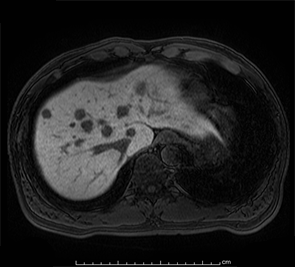Cancer that develops in the liver itself is called “primary liver cancer”, whereas cancer that develops in other organs that has spread to the liver is called “metastatic liver cancer”. Metastatic liver cancer is not “liver cancer”. For example, liver metastasis of colorectal cancer is colorectal cancer, and when using a chemotherapy, drugs that is effective against colorectal cancer are used.
All metastatic liver cancers are stage 4 cancers when they have metastasized to the liver and categorized as “advanced cancer”. However, depending on where the primary tumor (original location of the cancer) was, the nature of the tumor may differ, and the strategy of treatment and the possibility of cure also differ greatly.
①Colorectal liver metastases
The most common metastatic liver cancer in our field is colorectal liver metastases. Unlike other gastrointestinal cancers, colorectal cancer is one of the few cancers that can be cured under certain conditions if it can be completely resected even if it has spread to the liver or lungs. In recent years, highly effective chemotherapeutic agents have become available. So even if the metastatic lesions are unresectable at initial presentation, there remains a chance of surgery when good response to chemo is observed. Since there is no curative-intent treatment other than surgery for colorectal liver metastases, it is quite important not to miss the patients who can be candidate for surgery during chemotherapy. Currently, surgical indications for colorectal liver metastases may vary among surgeons and institutions. However, our team performs surgery in cases where surgery is considered meaningful, regardless of size or number based on the large number of experiences in aggressive surgery for multiple colorectal liver metastases. See details for multidisciplinary approach for advanced colorectal cancer here.
Below are the results of the initial hepatectomy for 101 cases of colorectal liver metastases that I had resected between 2014 and 2018. Median number of tumor was 6 (range, 1-83), maximum tumor diameter 32.3 mm (range, 5-150 mm), and 75% cases presented multiple lesions. Seventy-eight (77%) required re-excision for recurrence during the observational period. The overall survival rate of the entire population was 98.0% at 1 year, 74.0% at 3 years, and 60.7% at 5 years, respectively. When comparing the all stage IV patients who underwent resection of primary lesion at our institution, survival outcomes of liver-limited disease are significantly better (5-year survival rate, 60.7% vs. 35%, P<0.0001).

②Neuroendocrine neoplasms
Neuroendocrine neoplasm (NEN) occurs frequently in the pancreas and sometimes metastasizes to multiple organs including the liver. Tumors commonly referred to as carcinoids also belong to this disease entity. Although chemotherapy regimen exists for neuroendocrine tumors, surgery is the only hope for cure. Therefore, for cases that can be expected to be completely resected, aggressive surgical resection is performed as in the patients with colorectal liver metastases.
③GIST (Gastrointestinal stromal tumor)
GIST mainly develops in the gastrointestinal wall such as the stomach and intestines, and sometimes metastasizes to the liver. Imatinib and sunitinib are usually used to control the progression of the disease for stage IV GIST patients. However, surgery is sometimes effective for liver-limited metastases.
④Other metastatic cancers
Although there remain no definite evidence for liver metastases from gastric cancer, esophageal cancer, pancreatic cancer, biliary cancer, breast cancer, or ovarian cancer, our team aggressively treat patients who are expected to be benefitted from surgery under discussion of multidisciplinary treatment team at our institution.
